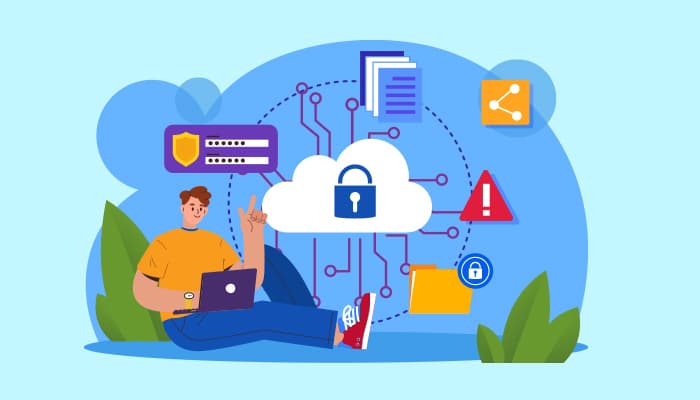Making the move to cloud computing has really shaken things up for businesses, hasn’t it? The whole scalability and flexibility game has gone to the next level now. But, with every digital upgrade, there arise a few hurdles. And guess what’s stealing the spotlight? Cybersecurity threats in the cloud – a real head-scratcher for companies around the world.
Now, let’s dive into the nitty-gritty of these cloud cybersecurity threats. It’s like navigating through a maze; but fear not! We’re here to discuss some of the top-notch strategies. Yes, we’re talking about beefing up those defenses with the mighty cape of cloud security services. Stick around, and let’s unravel the cloud security strategies together!
Understanding the Cloud Ecosystem
Cloud computing, with its various models such as Infrastructure as a Service (IaaS), Software as a Service (SaaS), and Platform as a Service (PaaS), has become an integral part of contemporary business operations. While the cloud provides various benefits, it also exhibits a larger attack surface for cybercriminals. Standard threats in the cloud comprise account hijacking, data breaches, unauthorized access, and insecure interfaces. So, let’s explore the top cloud computing security issues and solutions.
Decrypting the Threatscape: Cloud’s Hidden Cyber Challenges
As companies progressively migrate to cloud environments, these cyber threats have become a big concern. Common risks comprise unauthorized access, data breaches, and vulnerabilities in cloud infrastructure. Proactively addressing cloud cybersecurity threats needs effective strategies, including employment of continuous monitoring, advanced security measures, and dynamic threat intelligence.
- Data Breaches:
One of the fundamental issues in the cloud is unauthorized access to classified data. Whether it’s intellectual property, customer data, or financial records, data leakage can seriously affect organizations and their clients.
- Account Hijacking:
Cloud accounts are prime targets for cybercriminals looking for unauthorized resource access. Compromised credentials can give rise to service disruptions, data loss, and reputational damage.
- Insecure Interfaces & APIs:
The APIs and interfaces that enable interaction between cloud services are probable weak points and prone to threats. Insufficiently secured interfaces can be abused by attackers to maneuver or achieve unauthorized access to apps and data.
- Insufficient Access Management:
Unsatisfactory configuration of access controls and mishandling of user privileges can give rise to unauthorized users attaining elevated access, augmenting the risk of system compromise and data exposure.
- Advanced Persistent Threats (APTs):
APTs are persistent and stealthy cyber-attacks, often staged by organized and well-funded groups. In the cloud, APTs might go unnoticed for longer periods, focusing on the requirement for constant monitoring and threat intelligence.
- Zero-Day Exploits:
Zero-day exploits target weak spots that are unfamiliar to the public or software vendors. With highly dynamic cloud environments, promptly tackling these vulnerabilities is critical to avoid potential breaches.
- Insider Threats:
The landscape of insider threats has amplified in the cloud era. Employees, unintentionally or intentionally, can jeopardize data integrity. Cloud security services should integrate anomaly detection and behavior analytics to discover potential insider threats.
- Ransomware as a Service (RaaS):
RaaS attacks have transformed into a service model, where cybercriminals can contract ransomware tools. Cloud security services should evolve to combat these attacks by incorporating efficient incident response plans, strong backup solutions, and behavior-based detection.
Code Red to Code Secure: Strategies Elevating Cloud Security
Strategies for cloud security include proactive mechanisms such as encryption, access controls, and regular audits to defend cloud-based systems from growing cybersecurity threats. These strategies look to ensure user privacy, data integrity, and the adaptability of cloud infrastructure.
- Multi-Factor Authentication (MFA):
Implementing MFA offers an additional layer of protection by making users verify their identity through several modes. This significantly lowers the threat of unauthorized access, even though credentials are compromised.
- Encryption:
With robust encryption systems in place, you can protect data both at rest and in transit. This will ensure that even in case of data interception, it stays unreadable lacking the right decryption keys.
- Regular Security Audits:
Perform regular security audits to discover misconfigurations and vulnerabilities. Frequent assessments assist companies to stay proactive in countering potential threats before they encounter any cyberattack.
- Cloud Access Security Brokers (CASBs):
CASBs work as moderators between users and cloud service providers, offering an additional layer of security. They provide features such as threat detection, data loss prevention, and access controls to improve your overall cloud security.
- Continuous Monitoring:
Employing real-time monitoring solutions to promptly uncover unorthodox activities and likely security incidents. Automated monitoring tools can quickly analyze patterns and behaviors, assisting companies in responding to emerging threats swiftly.
- Employee Training & Awareness:
You can always invest in educating your employees about cybersecurity to build a culture of security awareness. Well-informed and trained users are less likely to be afflicted by phishing attacks and are highly likely to adhere to best practices for safer cloud usage.
- Behavioral Analytics & AI:
Leverage behavioral analytics and AI to identify patterns suggestive of cyber threats. This method is critical in discovering abnormal behavior in the ever-evolving cloud ecosystem.
- Automated Response Mechanisms:
Within a dynamic cloud environment, automated response mechanisms can assist in swiftly mitigating threats. Automated incident response, merged with ML, allows swift decision-making to prevent looming cyber threats.
- Continuous Security Training:
Identifying the evolving nature of cyber threats, companies should constantly train their security teams. This will make sure that security experts are well-prepared to manage evolving challenges and stay updated on emerging threats.
- Blockchain for Data Integrity:
Businesses can integrate blockchain technology to improve data integrity and alter resistance. This might be precisely beneficial in securing crucial transactions and data within cloud environments.
- Adaptive Access Controls:
Employ adaptive access controls that can be adjusted as per user behavior and context. This assists in avoiding unlawful access by adapting to the varying circumstances related to user interactions with cloud resources.
- Collaborative Threat Intelligence Sharing:
Nurture a collaborative method to threat intelligence sharing within the cloud ecosystem. Exchanging information related to emerging threats and attack patterns allows organizations to jointly strengthen their defenses against evolving cyber threats.
Code of Compliance: Deciphering the Regulatory Maze
The compliance challenge includes navigating and adhering to legal and industry standards for data security, privacy, and operations. Enterprises should adopt strategies to constantly supervise and address compliance issues, preserving stakeholder trust and ensuring legal adherence.
- Data Residency & Sovereignty:
Distinct industries and regions have certain regulations regulating data processing and storage. Navigating data sovereignty and residency needs is vital for ensuring compliance, specifically when handling sensitive data.
- GDPR & Data Privacy:
The General Data Protection Regulation (GDPR) sets strict rules for protecting sensitive information. Cloud security mechanisms should conform with GDPR needs, including breach notification, data encryption, and the right to be forgotten.
- Industry-Specific Regulations:
Several industries, like finance (PCI DSS), healthcare (HIPAA), and government (FedRAMP), have certain regulations directing data security. Cloud security services should be adapted to conform with these industry-specific compliance standards.
- Audit Trail & Documentation:
Regulatory compliance usually requires companies to maintain extensive audit trails and documentation associated with security measures. Employing strong monitoring and logging methods is vital for ensuring compliance throughout audits.
Beyond the Clouds: Unveiling Strategies for Compliance Success
Strategies for cloud security compliance include employing measures such as access controls, encryption, and persistent monitoring to satisfy regulatory requirements. These measures support legal adherence, boost the resilience of cloud environments, and foster trust within stakeholders.
- Compliance-Aware Cloud Service Providers:
Select cloud service providers that emphasize compliance and conform with industry standards. Major cloud providers provide compliance certifications, alleviating the burden on companies to satisfy regulatory requirements.
- Automated Compliance Monitoring:
Employ automated tools for persistent compliance monitoring. Such tools can track changes, examine configurations, and produce reports, delivering a proactive method to cope with compliance needs.
- Consistent Compliance Audits:
Perform regular external and internal compliance audits to maintain constant compliance with regulations. Periodic assessments help uncover gaps in compliance and offer room for corrective measures before possible regulatory problems arise.
- Encryption & Tokenization:
Leverage robust encryption and tokenization methods to defend your sensitive data. Such measures don’t just improve security but also ensure adherence to data protection regulations.
- Employee Training on Compliance:
Train your employees in the significance of compliance and their role in preserving a secure and compliant cloud environment. Cloud security awareness among employees is critical to avoid unintentional infringement of regulatory requirements.
- Incident Response Planning:
Create and constantly update incident response strategies that satisfy regulatory needs. A straightforward incident response plan is necessary to alleviate security incidents’ effects while maintaining compliance.
Summing Up:
While the cloud ecosystem introduces new avenues for efficiency and innovation, it also poses unique cybersecurity problems. Ensuring cyber security for small businesses is significant to secure their data, retain customer trust, and progress in the digital age. By embracing a blend of proactive measures, advanced technologies, and employee awareness, enterprises can navigate the cloud confidently and securely leverage the advantages of the digital revolution.







